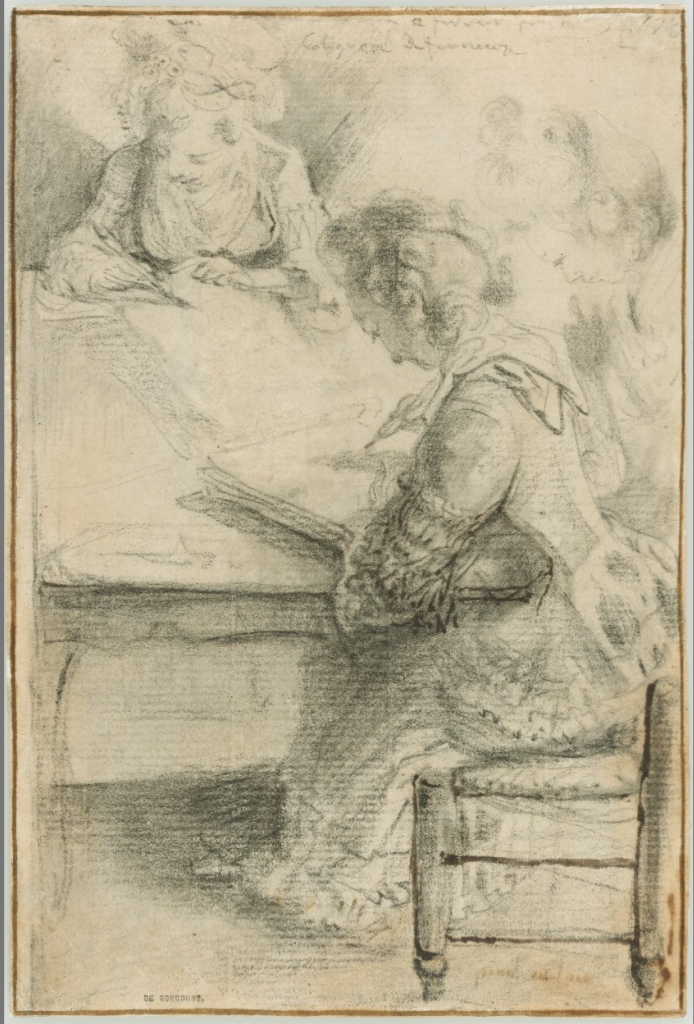Drawing of the Month #26
Saturday, 1 November 2025. Newsletter 26.
Gabriel de Saint-Aubin (1724–1780)
Three Young Women Drawing at a Table, c. 1778
Black chalk with selective wetting and pen and grayish-brown ink, 179 × 119 mm, J. Paul Getty Museum, Los Angeles, 2024.81
Julian Brooks, Senior Curator of Drawings at the J. Paul Getty Museum, Los Angeles, has kindly chosen our drawing of the month.
I often think of a drawing as a form of time machine to another period and place, a fragile and intimate piece of paper that—if you hold it and imagine the journey it has undertaken, right back to the moment of its creation—provides a distinct glimpse into a fragment of our history. I like to picture the artist, the circumstances, the scene.
In this sheet by the indefatigable draughtsman Gabriel de Saint-Aubin we can imagine the mixture of quiet concentration, the scratching of chalk on paper, perhaps nervous chitter-chatter, as the women sit around the table engaged in their pastime: drawing. Their own sketches may or may not survive for us today, but Saint-Aubin captures the moment and hands it to us. His focus is on their elegant hairstyles and dresses. Although the drawing is swiftly made in black chalk, he uses brown ink to convey details of the dress nearest him and to accentuate the solidity of the table and chair: an inscription at lower right in ink charmingly notes of the principal figure that one of her feet is in the air: pied en l’air.
This is one of thousands of sketches made by Saint-Aubin, who was described as drawing “at all times and in all places.” His sketchbook pages and annotated, self-illustrated auction catalogues provide us with a trove of information and an extraordinarily palpable sense of his age. Although this drawing was almost certainly made in a sketchbook, it was Saint-Aubin himself who detached it: a dedication in his handwriting at the top reads: 2 février - pour Mme[?] Colignon de Freneuse. 1778.
This is very possibly Louise-Victoire Fligny, the second wife of Charles-Clément Colignon de Freneuse de l’Épinard (1729-1785), or—if the dedication is read “Mlle Colignon de Freneuse”—it could be the only child from Charles-Clément’s first marriage, Louise-Charlotte Colignon de Freneuse (1763–1805), who would have been fifteen years old when the drawing was made. It’s appealing to think that she could be one of the young women we see sketching. (I’m grateful to the incomparable Neil Jeffares for his genealogical insights.)
The black stamp at lower left “De Goncourt” confirms the provenance of the sheet in the collection of Edmond and Jules de Goncourt, who rehabilitated Saint-Aubin’s reputation in the late nineteenth century (in his own time, Saint-Aubin was not considered a “proper” artist since he did not make large history paintings or work within another established genre). In their writings the brothers identify the Getty sheet as depicting three young women drawing, and we retain that title, although the profile at right is very possibly a subsidiary sketch of the principal figure, with similar curls and costume. And what are they drawing? It’s almost impossible to make out, but I sometimes think I see the face of a figure on the sheet of the young women farthest from us. Are they sketching each other?
This sheet by Saint-Aubin features in the exhibition Learning to Draw, which runs at the Getty until January 25th, 2026. In the exhibition we feature a drawing table where visitors can sketch from a plaster cast or some drawing manual pages. But it’s been noticeable that often visitors sketch another member of their party as they draw …

